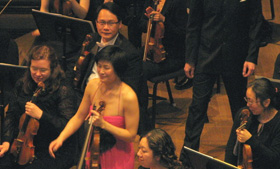Examiner.com
By Eugene Chan
March 27, 2011
original
link
Princeton Symphony Orchestra with violinist Jennifer Koh
Princeton Symphony Orchestra continued its season of thematic programming in its most recent concert entitled “Ethnic Explorations.” The program: “Thracian Echoes” (2002) by American composer Derek Bermel, Dvorak Violin Concerto with New York-resident Jennifer Koh and Bartok Concerto for Orchestra.
Bermel’s “Thracian Echoes” is a piece where the composer was influenced by the singing styles native to Bulgaria’s Thracian region. His orchestration includes Latin percussion instruments and Bermel uses the theatrical element of solos by wind or brass players either performing on the second level of the auditorium or off to the sides on the ground level.
“Thracian Echoes” is episodic. Within the first five or six minutes: piece opens with sliding strings that create a low mysterious wail that transitions into wind fragments bouncing off each other. Next is a section where percussion instruments quietly sound, followed by a short flute motif, and then echoed by trumpets. Principal clarinet picks up that motif, which in turn is answered by the percussion section.Clipped brass notes signal the next big change. Strings gradually accelerate and trumpets grow loud and more assertive.

Violinist Jennifer Koh taking bows at her recent
performance of the Dvorak Violin Concerto
with the Princeton Symphony. Photo: e. chan
For the next 15 minutes after that, the piece at ever shifting tempii, alternates between short bursts of melody contrasted by emphatic rhythmic passages embodied by brass and percussions sections respectively. The piece ends where it began, with the strings gradually trailing off.
Bermel's own voice--through the use of ancient means like call and response and imitation, influenced by Bulgarian song-- results in a fresh piece that engages the listener mentally. This reviewer would need additional live listens to decide if the piece is emotionally grabbing.
Dvorak Violin Concerto is a piece that throughout its three movements extensively alternates between unaccompanied solos by the violinist often followed and echoed by the full orchestra. Often the composer has the soloist act a rhythm instrument and Koh physically manifested that by throwing her full frame into those passages. The piece has numerous exposed singing lines where a soloist could act the diva, either through overuse of vibrato or stretching the tempi.That way was not for Koh. Koh’s choice of communicating this concerto was through a studied, grinding intensity colored by her dark timbre. She allowed Dvorak’s score to stand on its own.
Bartok Concerto for Orchestra is a staple of the standard orchestral repertoire. From the gifted student orchestra to the name professional orchestras of the world though, none treat this piece routinely for two reasons. Inherently, the piece is technically demanding. Moreover the entire orchestra has skin in the game, with virtuosic solos for principal wind and brass players.
For the Princeton Symphony, their skill and flair was tested, especially in the finale marked presto (very fast). Music director Rossen Milanov whipped the ensemble at a take no prisoner’s pace. This left the orchestra’s brass section in a raw and frenetic state. The sizzling string section tore up their passagework with intimidating command.
Kudos go to the ensemble's principal flute for her performances of the thin-textured solos in Bermel’s “Thracian Echoes” to handling the athletic work in the second and fifth movements of Bartok’s Concerto for Orchestra.
Copyright ©2011 Examiner.com
© Jennifer Koh, All Rights Reserved. Photography by Juergen Frank. Site by ycArt design studio